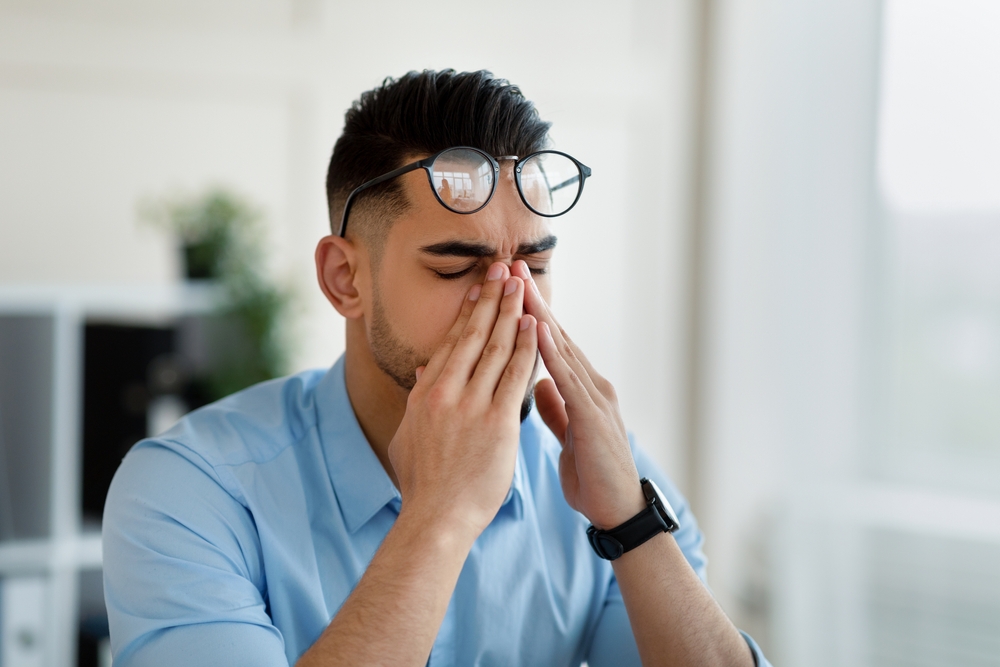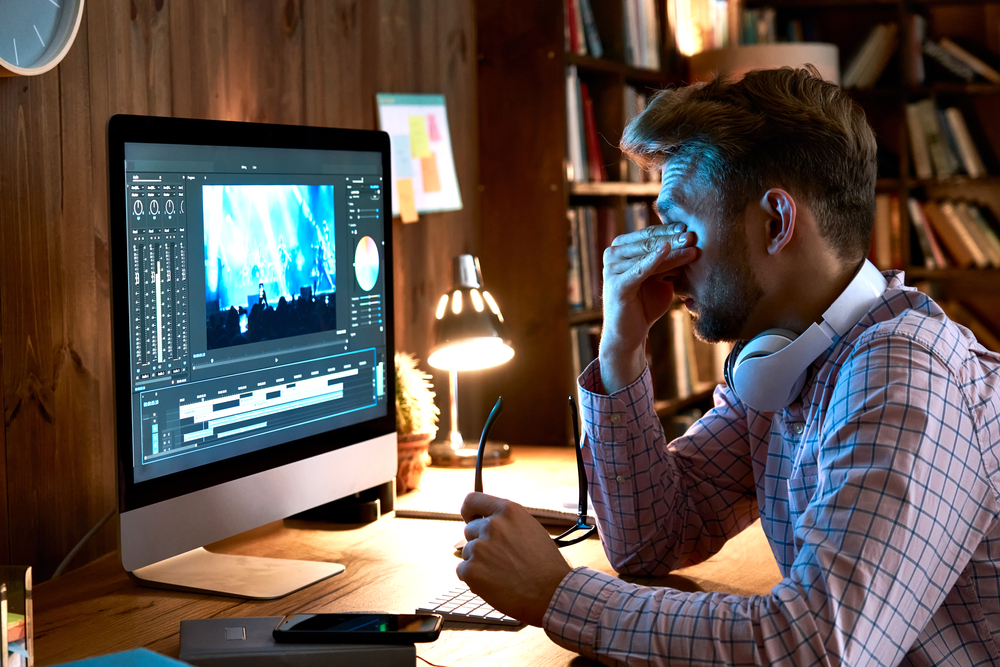Do you have dry, irritated eyes? Do you frequently spend long periods of time on digital devices?
Whether it’s for work, entertainment, or school, it’s easy to spend too much time on your phone, computer, or TV. However, prolonged screen exposure can impact your vision and eye health.
Keep reading to learn whether your screen time is making your dry eyes worse and what you can do to improve your symptoms.
What are Dry Eyes?

Dry eyes, or dry eye syndrome, can occur when your tears evaporate too quickly or your eyes can’t produce enough tears to stay moist. It usually affects both eyes, causing symptoms such as:
- Eye redness
- Blurred or double vision
- A burning or stinging sensation
- Eye fatigue
- Sensitivity to light
- Strings of mucus in your eyes
- Trouble wearing contact lenses
- Gritty or scratchy feeling
- Excessive tearing
How Can Your Screen Time Worsen Your Dry Eyes?
Staring at digital screens for prolonged periods can exacerbate dry eyes in the following ways:
Digital Eye Strain
Digital eye strain or computer vision syndrome is a condition that happens when your eyes become exhausted from too much screen time. The symptoms of digital eye strain can affect your focus, productivity, and overall quality of life.
They include:
- Eye fatigue
- Dry eyes
- Headache
- Double, blurred, or fluctuating vision
- Redness
- Trouble concentrating
- Stinging sensation
- Increased light or glare sensitivity
- Sore shoulders, back, or neck
- A feeling of something in the eyes
Blue Light Exposure

Digital screens emit blue light that can affect your eyes. Overexposure to blue light can contribute to digital eye strain.
It can also worsen your symptoms if you already have dry eyes.
Decreased Blink Rate
Too much screen time significantly worsens dry eyes, as excessive exposure can disrupt blinking. Blinking prevents dryness and keeps your eyes healthy.
With every blink, your eyes are coated with fresh tears that ensure they remain lubricated and comfortable. However, when you’re focused on your laptop or phone, your blink rate can reduce by more than 50 percent.
This decline in blink rate keeps your eyes open for longer, causing tears to evaporate faster and leading to dryness.
Incomplete Blinking
Even if you blink when focusing on a screen, you’ll likely not have complete blinks. Incomplete blinking is when your upper and lower eyelids don’t fully touch during a blink, leaving parts of your eye’s surface exposed.
A complete blink ensures that your tears spread evenly across the eye surface. On the other hand, incomplete blinking leaves small gaps between the top and bottom eyelids.
This can create dry spots on the eye’s surface that won’t get refreshed with new tears, aggravating dry eyes.
Lack of Proper Hydration
When you’re binge-watching your favorite TV show or busy on your computer for hours, it can be easy to forget to drink enough water. This may lead to dehydration.
Your eyes produce fewer tears when you’re dehydrated, which can cause your dry eyes to become worse.
How Can You Protect Your Eyes While Using Screens?
Although you might not be able to entirely avoid screens, you can take steps to reduce their impact on your eye health, including:
Follow the 20-20-20 Rule
When using digital devices, follow the 20-20-20 rule to prevent eye strain and dry eye caused by excessive screen time. It involves taking a 20-second break every 20 minutes and looking at something 20 feet away.
These frequent breaks will allow your eyes to rest, relax, and rehydrate. When taking these breaks, also make it a habit to blink intentionally.
Blinking deliberately will keep your eyes lubricated and comfortable. You can set a reminder on your phone to ensure you remember to take regular screen breaks.
Adjust Screen Settings
Your eye comfort and screen setup go hand in hand. Consider placing your screen at or slightly below eye level to help you blink more frequently and increase eye comfort.
Also, ensure the screen brightness matches the light level in your environment to further reduce eye strain.
Stay Hydrated

Proper hydration supports tear formation, which keeps your eyes moist and lubricated. If you find it challenging to drink enough water throughout the day, you can complement your water intake with broth and caffeine-free herbal teas like hibiscus, chamomile, and mint to reach your hydration goals.
Water-rich vegetables and fruits such as cucumber, celery, lettuce, apples, tomatoes, zucchini, and peaches are extra hydrating and can also increase your daily water intake.
Use Artificial Tears
Over-the-counter artificial tears offer quick relief from dry eyes. They mimic natural tears, temporarily alleviating irritation and dryness.
If you spend too much time in front of screens, artificial tears can restore moisture and soothe your eyes. However, if you need to use them constantly, it’s best to see your eye doctor.
They can recommend or prescribe the most appropriate eye drops for your specific visual needs.
Relieve Digital Eye Strain and Dry Eyes
If eye strain and dry eye from excessive screen time are affecting your vision, productivity, and daily life, our experienced ophthalmologists can help. They’ll get to the bottom of your symptoms and create a highly effective and personalized treatment plan to bring you lasting relief.
Is too much screen time worsening your dry eyes? Schedule your appointment at Jacksonville Eye Center today to take the first step to clear, comfortable, and healthy vision.

